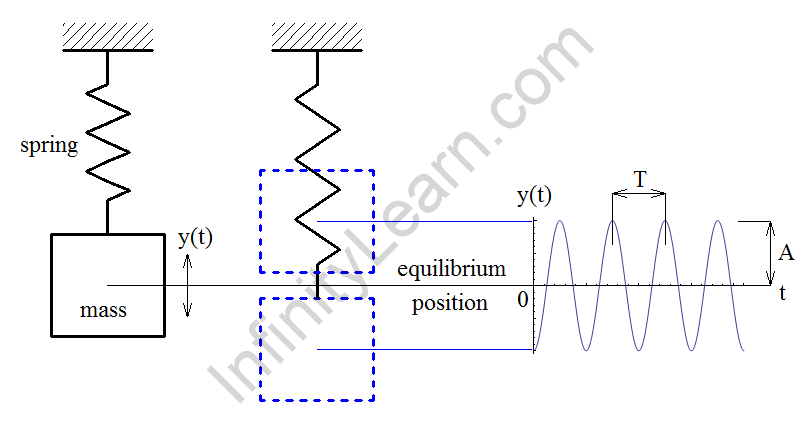Table of Contents
This chapter “Physics Formula for Simple Harmonic Motion” is useful for CBSE, ICSE, and entrance exams such as JEE and NEET. A particle with a mass of 0.1 kg performs a simple harmonic motion under the action of a force F = (-10x) N. The speed of the particle in the middle position is 6 m/s. SGM is an oscillatory motion in which the acceleration of a particle at any point is directly proportional to the displacement from its average position.
A particle is said to perform simple harmonic motion if its acceleration is proportional to its displacement from a fixed point and always points towards that point. Its acceleration always points to a fixed point on the line, and its strength is proportional to the particle’s displacement from that point.

Equations for SHM:
- “The distance that a vibrating particle moves from its average position at any time t is called displacement”.
- The amplitude of a vibrating particle is defined as its maximum displacement from the mean position. It is clear from the front that at the intermediate position y = 0, the velocity of the oscillating particle is maximum and the acceleration is zero.
- The solution to the above differential equation is the angular position of the particle concerning time. Suppose the particle is at P after time t. If o is the angular velocity, then the angular displacement θ with time t is given by θ = o t . At t = 0, the particle is at point P (moving to the right).
- The equation of motion x(t) = A cos (ω t) is useful for modelling data with magnitude A and zero initial velocity at the block position at the initial time instant t = 0.00 s. The block starts to oscillate in the SGM between x = + A, and x = – A, where A is the motion amplitude and T is the oscillation period. The equation of motion is the generalized equation of SHM, where t is the time in seconds, ω is the angular frequency in reciprocal seconds, A is the amplitude measured in meters or centimeters, and ω is the phase measured in radians move.
Period and frequency of motion of a mass on a spring :
An interesting feature of the SGM of an object attached to a spring is that the angular frequency, and hence the period and frequency of the motion, depend only on the mass and the force constant, and not on other factors such as the range of motion. Any movement that repeats itself at regular intervals is known as a periodic movement. Periodic motion in which the system returns to its original position after some time.
The time it takes an object to oscillate is called a time period. The minimum time after which the particle continues to repeat the movement of the particle is called the time period (or) the shortest time required for the oscillation to complete is also called the time period.
When a particle moves back and forth around a fixed point (called the equilibrium position) along a straight line, its motion is called simple linear harmonic motion. If a particle moves at a uniform speed along a circle, the linear motion of the base of the vertical line drawn by the particle on the diameter of the circle is called simple harmonic motion. This means that the particle is in a uniform circular motion (its projections M and N) and (K and L) in simple harmonic motion around O with the same angular velocity as P.
Oscillatory motion
An oscillatory motion is a special case of vibration along with a straight line between two extreme points (the path from the Simple Harmonic Motion chapter is a limitation). Example Uniform circular motion. Rock back and forth in the middle position as the string and weight move.
Simple harmonic motion or SGM is defined as motion in which the restoring force is proportional to the displacement of the body from its average position. The motion of the pendulum is a simple harmonic motion only when the maximum angular displacement ω is small. The curve between displacement and velocity of a particle in simple harmonic motion is an ellipse.
- “In oscillatory motion, displacement, velocity, acceleration, and force change (with respect to time) in a way that can be described by both sinusoidal (or cosine) functions, collectively referred to as sinusoids”.
It has been observed that two particles intersect when they move in opposite directions, and it has been noted that each time their displacement is half their amplitude. The damping force is always directed against the acceleration.
Now, if the force is F, the displacement of the spring from the equilibrium position is x. The mass moves a distance x from the equilibrium position towards the centre, pushing it with velocity v at time t = 0.
The total energy of a particle in the SGM is constant and does not depend on the instantaneous displacement. The speed v of a particle moving in a circle can also be obtained by decomposing it into two components, as shown in the figure. If the resulting force can be described by Hooke’s law and there is no damping (deceleration due to friction or other non-conservative forces), then a simple harmonic oscillator oscillates with the same displacement on either side of the equilibrium position, as shown for the object on a spring.
FAQs
How important is SHM in Physics JEE?
Particularly SHM is very important. Every chapter in electrodynamics will include some questions about SHM. Also in JEE 2/3 of questions related to SHM shows up.
What is simple harmonic motion (SHM)?
SGM is an oscillatory motion in which the acceleration of a particle at any point is directly proportional to the displacement from its average position.



